
Their optimism is based on the initial signs of stability in the external and fiscal accounts in the first five months of the Extended Fund Facility (EFF). It is claimed that the stage is set for sustained economic growth. If it happens, Pakistan will probably be the first country to take off into growth while still in an IMF programme, and against her own experience. The entire literature until 2000 found a negative relationship between the IMF programmes and economic growth. Since 2001, some studies concluded that growth returns two years after the end of the programme. IMF’s own case studies are not exactly gung-ho about growth. Nor are Greece and Argentina the poster girls of growth.
At home, take the case of the last EFF from September 2013 to August 2016, completed and declared somewhat successful. Ishaq Dar always made it clear that the principal objective was to repay the previous IMF loan and an understanding IMF granted waiver after waiver. Before the programme, GDP growth in FY2013 was 3.68%. In FY 2014, with three quarters under the programme, growth inched to 4.05. With the programme in full gear in FY2015, growth at 4.06% was nearly unchanged. It was only in FY2016, the last full year of the programme, that growth picked up to 4.56%. Generous waivers and the prospects of the end of the programme were the main contributors. As the IMF left in the first quarter of FY2017, growth began to regenerate, 5.22% in FY17 and 5.53% in FY2018.
During Musharraf’s period, another favourite of the regime, growth under the Poverty Reduction and Growth Facility (PRGF) from December 2001 to December 2004 was high and increasing. However, the PRGF was preceded by a harsh Stand-By Arrangement (SBA) from November 2000 to September 2001. From 3.65% in FY2001, growth crashed to 2.37% in FY2002. It picked up to 5.64% in FY2003 under PRGF which explicitly aimed at reviving growth. It is another matter that after the self-imposed SBA initially and the completion of the EFF, the government wishes to continue the relationship with the IMF under a Poverty Reduction and Growth Trust facility, the new name for PRGF.
The relevant adviser has been more cautious. In November, he talked about a positive growth trajectory and surpassing the low growth target of 2.4%. “If we manage to complete the IMF programme, it would provide [a] good platform.” The man to watch, however, is the State Bank Governor. His belief in the IMF prescription is unshakeable. Fiercely guarding his own autonomy but influencing other key policies with powerful backing, he thinks that inflation is likely to be more than the government projections. So forget about lower interest rates any time soon. As the State Bank’s latest annual report states: “Macroeconomic stabilization will continue to be the cornerstone of economic policies during FY20. Real GDP growth is likely to remain subdued, though the early signs of recovery are already visible.”
Too bad that Argentina — fresh from the IMF oven — reconfirms the trade-off between austerity and growth.
Published in The Express Tribune, January 3rd, 2020.
Like Opinion & Editorial on Facebook, follow @ETOpEd on Twitter to receive all updates on all our daily pieces.


1729662874-0/One-Direction-(1)1729662874-0-165x106.webp)








COMMENTS (1)
Comments are moderated and generally will be posted if they are on-topic and not abusive.
For more information, please see our Comments FAQ